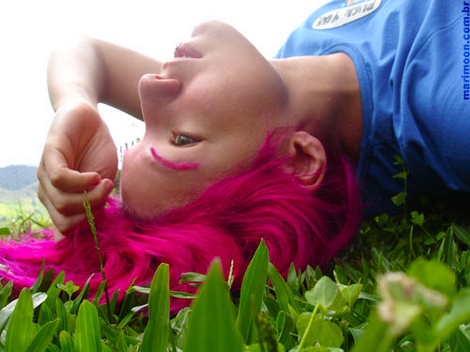Dangerous Side of Synthetic Hair Dyes
It is fashionable to go blond nowadays or, alternatively, to proudly wear a full head of locks dyed in a whole rainbow spectrum, but how does bleaching and dying of hair can affect the strength of the follicles and your general health? A hair-colouring procedure is usually performed in a salon and requires repeated visits to keep your hair decent-looking. Once you’ve decided on colouring your hair, there is no way back! Be ready to spend hours sitting in a salon chair with foils attached to your head and the smell of ammonia and other toxic chemicals penetrating your nostrils. Be ready to deal with scalp irritation, burnt and thinned hair shafts, allergies, and other unpleasant side effects of hair colouring. After all, beauty requires sacrifice!
Both men and women have been colouring their locks for millennia, but the dyes they used were entirely plant-based and “organic”. History tells us that even cavemen put ochre and clay on their dreadlocks to decorate themselves and please the spirits of hunt. Famous Cleopatra applied to the help of such natural hair-colouring ingredients as turmeric, hulls of black walnut, and indigo. In ancient Russia, women used flowers of chamomile and onion husks to give their hair a blond tint. In India, various herbs are still predominantly used to mask greyish curls and deepen their naturally dark, beautiful colour.
Unfortunately, since the beginning of the 20th century, European and American populations have become reluctant to use naturally-based substances to care for their locks and bodies. Instead, numerous “modern” synthetic ingredients have been introduced and aggressively promoted by their manufacturers. And, although the era of industrialisation brought numerous comforts and advantages to benefit people, it also gave us artificial foods, car exhausts, petrochemical “beauty” products, and many harmful hair dyes that were supposed to make our hair colour shine and last for a long time.
Every woman who at least once underwent the salon procedure of altering her hair shade can confirm that hair colouring can offer a fun and even identity-shifting transformation. However, hair-dyeing stinks, and not only in its direct sense. All modern hair colours contain highly allergenic chemicals that adversely affect the health of our hair. They can trigger scalp redness, itch, dryness, and swelling, especially in sensitive individuals. Even worse so, a regular exposure to hair dyes can provoke, or contribute to the development of such diseases as cancer, hay fever, arthritis, and leukaemia.
And all those synthetic colours do not just damage your scalp and health – they also find a way into the water supply polluting the environment with residual petrochemicals and various carcinogens.
Experts estimate that over 40 percent of all women, as well as some men, use hair colours on a regular basis. While these dyes have a number of ingredients, more than half of them are allergy-inducing “sensitisers”, the most dangerous of which is PPD, or P-Phenylenediamine. This aromatic amine is linked to numerous allergic reactions, including anaphylaxis, tissue swelling, difficulty breathing, and scalp puffiness and irritation. Besides, it can provoke the development of follicular lymphoma – a form of blood cancer. Dark hair dyes usually contain huge amounts of PPD. Even some herb-based hair colours, such as henna, can feature substantial quantities of PPD.
Luckily, there are now healthier are more eco-friendly colouring options available on the market, which have a gentler effect on both your hair and the environment. You do not really need to use PPD in order to get a beautiful, long-lasting hair colour. Chemical-free, organic dyes which are based on natural colouring herbs and which do not feature substances like ammonia or parabens are becoming increasingly popular with health-conscious consumers. Such products often contain beneficial extracts of chamomile, citric fruits, or aloe vera. Besides, most of these organic dyes are as effective and last as long as conventional hair colours.
Eco-friendly dye alternatives, such as Organic Colour Systems, Logona, or Tints of Nature, can be purchased online or from your local Planet Organic market.
Christiana Roberts
Posted on July 9, 2008
Filed Under Hair Care
Comments
Leave a Reply

